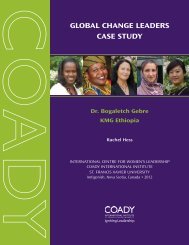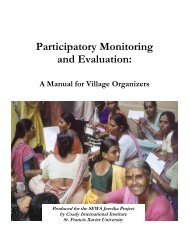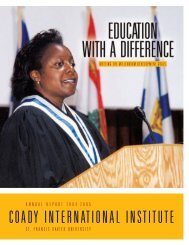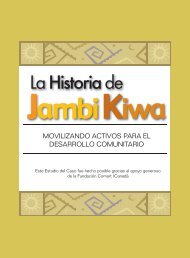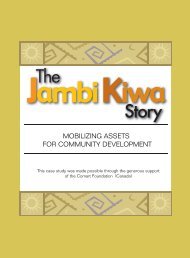Fort McKay First Nation, Alberta - Coady International Institute - St ...
Fort McKay First Nation, Alberta - Coady International Institute - St ...
Fort McKay First Nation, Alberta - Coady International Institute - St ...
You also want an ePaper? Increase the reach of your titles
YUMPU automatically turns print PDFs into web optimized ePapers that Google loves.
esentatives on a regular basis to discuss the successes and challenges of current reclamation efforts<br />
with regard to the cultural keystone species.<br />
It is easy to see why Cecilia Fitzpatrick considers the continuous dialogue on reclamation issues<br />
between her community and the industry as the major achievement during her work as <strong>Fort</strong><br />
<strong>McKay</strong>’s Environmental Coordinator. When asked about what prompted her to initiate this process,<br />
she simply says, “I guess it was a calling. This was what I had to do.”<br />
Commitment to Place<br />
fort mCKay fIrst natIon, alBerta 9<br />
Many of <strong>Fort</strong> <strong>McKay</strong>’s women leaders and activists had to leave their community for a certain period<br />
in pursuit of education or work opportunities. However, at some point in their lives, each felt<br />
the urge to return to the land of their people - and followed that urge.<br />
Dorothy McDonald-Hyde left <strong>Fort</strong> <strong>McKay</strong> to attend high school in Edmonton. As related by<br />
her daughter Dayle, “It was really hard for her to leave the community. . . but I think that being sent<br />
away to school and being told [by my grandfather] that that was something she just had to do. . . so<br />
that she could come back and help her community - that’s where she drew her strength.” Inspired<br />
by love for her people, she returned to help them go through a critical juncture in <strong>Fort</strong> <strong>McKay</strong>’s history,<br />
always staying true to her father’s wish - “keep our pride and negotiate with industry [to] get<br />
the best of both worlds” (in <strong>St</strong>eele, 2005).<br />
Cecilia Fitzpatrick had a homecoming story of her own. After marrying a Newfoundlander<br />
she settled in <strong>Fort</strong> McMurray, raising their children and eventually getting a job as a heavy equipment<br />
operator at Syncrude. As the years went by, the combined demands of home and work started<br />
to take a toll on her health: “Raising four boys and doing shift work driving trucks was really hard,<br />
and I was not that young anymore.” And on top of that, “my brother was always phoning me and<br />
saying: ‘It is time for you to work for your people.’” It was his persistent urging, says Cecilia that ultimately<br />
prompted her to turn her gaze back to <strong>Fort</strong> <strong>McKay</strong>. She had long held the dream of following<br />
in the footsteps of her father and her older sister Dorothy; her brother’s words rekindled that<br />
dream. By taking on the duties of environmental coordinator for <strong>Fort</strong> <strong>McKay</strong> <strong>First</strong> <strong>Nation</strong>, Cecilia<br />
pledged to work towards implementing her father’s teachings, which she always remembered.<br />
My father would tell you that our body is like the earth. We need a heart to live. And he<br />
would tell you that the muskeg is your heart, and that the mountains are your brain, and<br />
that the creeks and rivers are your blood vessels. . . . And he would say: because of that,<br />
you have to look after the land. And if you will not look after it, your heart will stop. (Fitzpatrick,<br />
2004).<br />
Cecilia came back home at a moment when her people desperately needed someone with a deep<br />
passion for their land and a vision to lead the fight for protecting its spirit. She had both.




